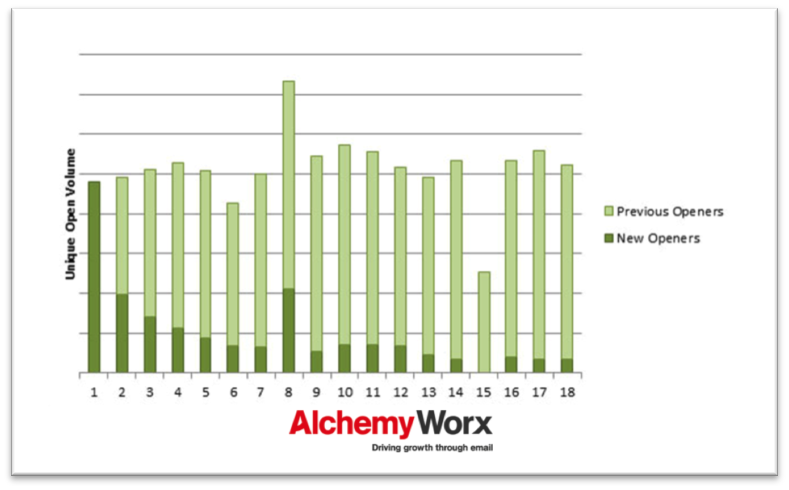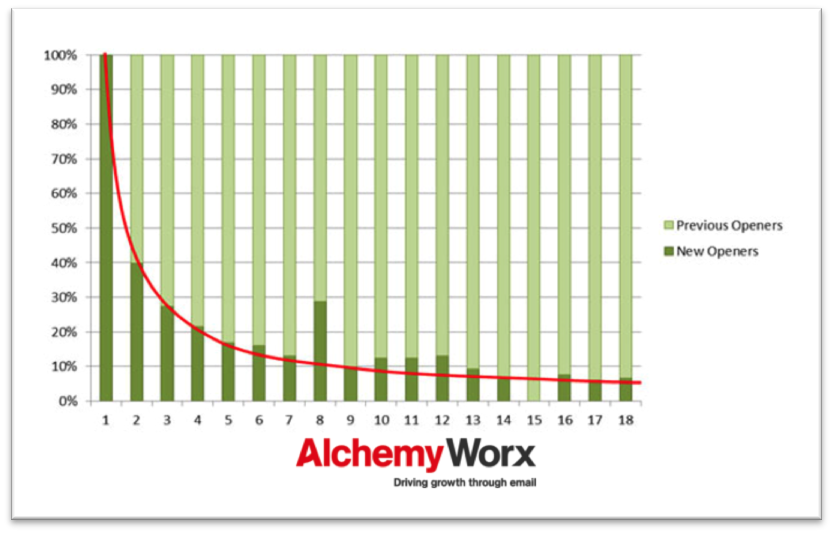Quist: Powerful Email Reactivation Hack Anyone Can Use
Current Best Practice
When it comes to your inactive subscribers, best practitioners have always advocated that you stop mailing them. Following this advice will have the immediate effect of improving your open rates without you having to do anything difficult like write better subject lines or improve your content and/or creative.
Here is how that works. You have a list of 100,000 customers and prospects and your average open rate is 20%, which gives you 20,000 opens on average. Now say 40%, 40,000 of them have not opened an email for 12 months or more (not untypical), so you decide to stop mailing them, your open rate will go from 20% (20,000/100,000) to 33% (20,000/60,000). You just increased your open rate by 66%!
Anyone who is familiar with my views will know this is a practice I disagree with for the simple reason our data shows unopened emails still influence people on your list in a positive revenue generating way. We are not the only ones who see this as this very powerful study by Mailchimp shows. My other objection is simple you cannot reactivate or learn how best to reactivate subscribers if you stop mailing them
There is one thing we can all agree on, whether you continue to mail inactives or not, reducing their numbers is a good thing. Which brings us of course to the question of how to go about reactivating these people.
A typical reactivation campaign goes like this: Decide on a definition of inactive, typically this is people who have not opened an email for 12 or more months although a significant number of marketers have 6 months as the cut off. Once you have done that you send out a reactivation email periodically or set up an automated email with subject lines like: We've missed you | It's been a while, Was it something we said? |Did we do something wrong? Containing a warning that you are about to stop mailing them unless they take some sort of action such as clicking on a link. This CTA may also be accompanied by some sort of incentive or offer.
The problem with this approach, as anyone who has ever tried a reactivate campaign quickly discovers, only a very small number of inactive subscribers ever respond to reactivation campaigns. Worse still the very fact that you sent out the campaign telling them you will stop mailing unless they take action means you can never reactivate them and are therefore forced to reacquire them via other more expensive channels.
The Hack – Turn every email you send into a reactivation learning opportunity
Focus on subscriber behavior open rate. Using the example above if your email campaigns have an average open rate of 20% how many of your subscribers will have opened one or more emails after 12 months?
20,000? In which case the same people opened every email and your inactive list will be 80,000
100,000? In which case everyone will have opened one email and your inactive list will be Zero.
The truth will be somewhere in the middle. Some subscribers – there will be a few that open every email you send. Some will never open in that time (typically 40% - 60% of the list unless you remove them). Everyone else sits somewhere between those extremes.
By measuring how of the subscribers who open every email you send are people who have opened before and how many are people who are opening for the first time you will be able to quickly identify which of your subject lines, offers, mailing frequencies days of the week and times of year are most effective at reactivating subscribers as the chart below shows.

The chart above shows the volume of opens by week showing how many subscribers are opening for the first time and how many are repeat openers. Everyone in the first week, however many they opened previously, is doing so for the first so for the first time for the measurement period. As you can see some weeks (week 8) generate above average reactivations while others (week 15) very few.
Every new opener shown as dark green is reactivated.
Stop guessing – learn from your campaigns what makes your customers reactivate daily or on a weekly basis. For an email program with consistent content, a stable mailing list and regular send frequency, the relationship between the previous openers and new openers follows a classic long tail shape. If there is a lot of variation in the open volume this can also be viewed as percentages of open volume to make comparing mailings easier, see below.

Identifying mailings that divert from this smooth line allows you to identify tactics that were effective at getting non-openers to open for the first time, or tactics that made past openers open again. This chart can be drawn up and analyzed for opens or clicks; even better, compare the two to get a really detailed picture of what's happening.
It's easy to see how useful this is when thinking about how to engage someone that hasn't opened in a while. When you want to drive opens from long-term non-openers, think about your email content, contact strategy, cross-channel tactics, offer and the email subject line.
Look at those mailings that cause the 'new openers' section of each bar to push above the red trend line. What was the subject line and how did it differ from the rest? What other factors might be responsible? For example, we have found that using 'free delivery' in the subject line tends to be very effective at driving repeat purchases but has little effect in reactivating subscribers.
Draw up some hypotheses and test these to see if you can reproduce the result. If you can, use them regularly and you're well on the way to reducing your inactive file putting the traditional but ineffective reactivation campaign on the back-burner.
One final tip
Mix things up. We have found regular tactical changes – in frequency, subject line length, time of day or day of the week reactivates inactive subscribers. Remember don’t do this too much or change becomes the norm.

 How to resolve AdBlock issue?
How to resolve AdBlock issue? 
 Dela Quist, is CMO of Alchemy Worx, the largest email marketing agency. He is a highly
Dela Quist, is CMO of Alchemy Worx, the largest email marketing agency. He is a highly